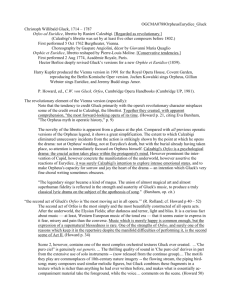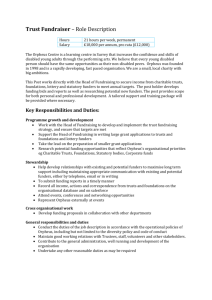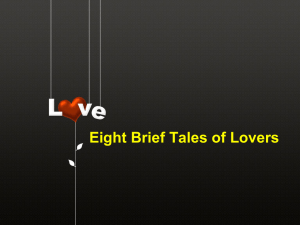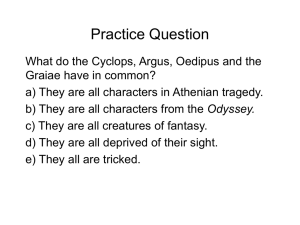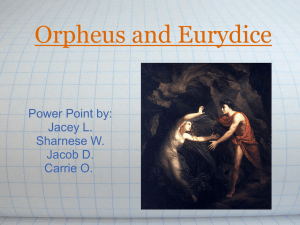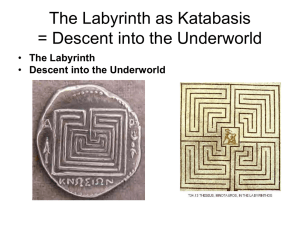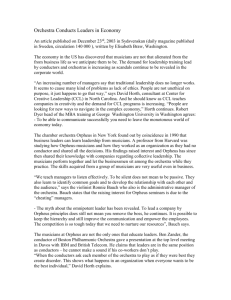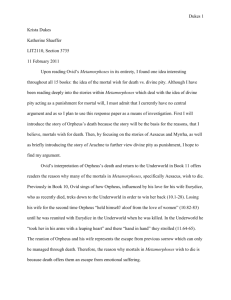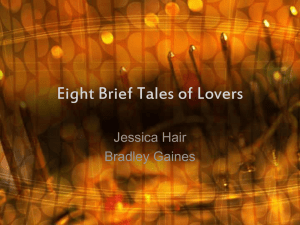“Our demigod” – Divinity and humanity in Monteverdi`s L`Orfeo and
advertisement
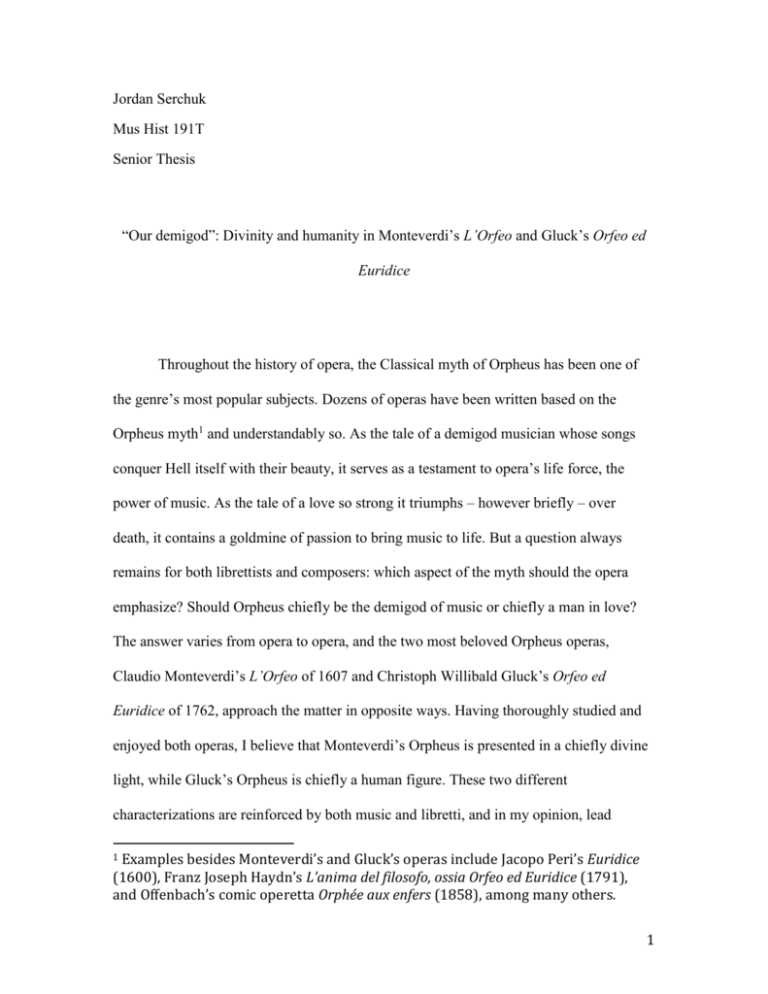
Jordan Serchuk Mus Hist 191T Senior Thesis “Our demigod”: Divinity and humanity in Monteverdi’s L’Orfeo and Gluck’s Orfeo ed Euridice Throughout the history of opera, the Classical myth of Orpheus has been one of the genre’s most popular subjects. Dozens of operas have been written based on the Orpheus myth1 and understandably so. As the tale of a demigod musician whose songs conquer Hell itself with their beauty, it serves as a testament to opera’s life force, the power of music. As the tale of a love so strong it triumphs – however briefly – over death, it contains a goldmine of passion to bring music to life. But a question always remains for both librettists and composers: which aspect of the myth should the opera emphasize? Should Orpheus chiefly be the demigod of music or chiefly a man in love? The answer varies from opera to opera, and the two most beloved Orpheus operas, Claudio Monteverdi’s L’Orfeo of 1607 and Christoph Willibald Gluck’s Orfeo ed Euridice of 1762, approach the matter in opposite ways. Having thoroughly studied and enjoyed both operas, I believe that Monteverdi’s Orpheus is presented in a chiefly divine light, while Gluck’s Orpheus is chiefly a human figure. These two different characterizations are reinforced by both music and libretti, and in my opinion, lead Examples besides Monteverdi’s and Gluck’s operas include Jacopo Peri’s Euridice (1600), Franz Joseph Haydn’s L’anima del filosofo, ossia Orfeo ed Euridice (1791), and Offenbach’s comic operetta Orphée aux enfers (1858), among many others. 1 1 naturally and inevitably to the operas’ two divergent and often criticized endings. Furthermore, they each reflect what we know of their composers’ respective artistic goals, as well as the cultural sensibilities of their respective audiences, those of the late Renaissance/early Baroque period and the Age of Enlightenment. Orpheus, according to mythology, was the greatest musician who ever lived, the son of the god Apollo and the muse Calliope. 1 All of nature was moved when he sang or played his lyre. When his lovely young bride Eurydice died of a snakebite, he descended to the Underworld and, with the power of his music and impassioned pleas, persuaded the gods of death to restore her to him. They agreed, but on the condition that he not look at Eurydice until they return to the upper world. Tragically and predictably, he could not resist looking back. In the original GrecoRoman myth he lost Eurydice forever, returned to the upper world in despair and met his own tragic death soon afterward. Over the centuries, many operas have been composed based on the Orpheus myth, but none more renowned than those of Monteverdi and Gluck. Monteverdi’s L’Orfeo, libretto by Alessandro Striggio, is considered by the majority of scholars and audiences to be the first operatic masterpiece ever written. Gluck’s Orfeo ed Euridice,3 libretto by Ranieri de’Calzabigi, is the first of the composer’s “reform Virgil. Georgics. Trans. Peter Fallon (New York: Oxford University Press Inc, 2006), pp. 90-93. Ovid. Metamorphoses. Trans David Raeburn (London: Penguin Books Ldt, 2004). pp. 382-386 3 Gluck’s opera exists in multiple and extremely different editions. In 1774, the opera premiered in Paris as Orphée et Eurydice, for which occasion Gluck made sweeping musical revisions, entirely rewrote the recitatives, added a vast number of 1 2 operas,” considered to have rescued the genre of Italian opera from the stilted conventions of Baroque opera seria, replacing its “over-elaborate vocal ornamentations”4 and “often absurdly complex”5 plots with both text and music of “beautiful simplicity.” 6 In keeping with the theatrical convention of their time periods, both operas replace the tragic conclusion of the original myth with a happy ending.7 L’Orfeo ends with Orpheus transported up to Heaven by his father, Apollo, to gaze forever on Eurydice’s image in the stars. In Orfeo ed Euridice, the love-god Amor (Cupid) takes pity on Orpheus and restores Eurydice to life despite the earlier decree, and the couple returns to earth to celebrate the triumph of love. Joseph Kerman, in the chapter “Orpheus: The Neoclassical Vision” of his 1956 book Opera as Drama8 argues that Monteverdi and Striggio’s Orpheus is a man of ungoverned, raw passion, a more emotional and flawed human being, while Gluck and Calzabigi’s Orpheus is a paragon of controlled, sublimated feeling, a purer, more ethereal hero. He argues that this difference is largely due to an important stylistic new arias and ballets, and transposed the alto castrato role of Orpheus for a tenor. Until the end of the 20th century, the opera was most often performed in this edition or in other editions based on it, such as Hector Berlioz’s 1859 revision. This discussion, however, focuses solely on the original, 1762 Italian version of the opera. 4 Howard, Patricia, comp. C.W. von Gluck: Orfeo (Cambridge Opera Handbooks) (Cambridge: Cambridge University Press, 1981), 16. 5 Ibid., 20. 6Gluck, preface to Alceste, 1776. 7 Two different conclusions actually exist for L’Orfeo. The first printed libretto maintains the tragedy of the original myth, while the first published score ends with happy apotheosis. Which ending was written first and which was actually performed in 1607 remains unknown. Kerman, Joseph. Opera as Drama: New and Revised Edition (Los Angeles: UCLA Press, 1956, revised 1988), pp. 18-38 8 3 change that took place in Italian opera between 1607 and 1762: the shift from recitative to aria as the primary means of emotional expression. Monteverdi’s Orpheus sings mostly in recitative designed to “imitate the actions of passionate speech,” with “sudden halts and spurting cascades in rhythm” and “intense rises and falls in melodic line.”9 As a result his music consists of “tumbling emotion, a continuing heart-cry, undistanced… its magnificence and immediacy stem exactly from its impulsive nature, from its lack of formal control.” The music of Gluck’s Orpheus, by contrast, is characterized by formal control, with “a tranquility beyond anything Monteverdi could achieve.” He sublimates his emotions, Kerman argues, by controlling them into sweet, neatly structured, sublimely beautiful arias, such as the strophic ‘Chiamo il mio ben cosí’ (“Thus I call for my love”) in Act I and the beloved C-major rondo ‘Che faro senza Euridice?’ (“What shall I do without Eurydice?”) in Act III. Arias like these are non-existent in Monteverdi’s opera. “Orpheus is shown to pull himself together,” Kerman writes, “to a point where grief is viewed and understood, no longer lived, but not shunned either. He transcends his sorrow by controlling it into song.”10 According to Kerman, this difference in the two characterizations is blatantly clear in the libretti as well. Monteverdi and Striggio’s passion-driven Orpheus impulsively vows to journey to the Underworld as soon as he receives the news of Eurydice’s death, and when he successfully reclaims her, his response is a proud, 9 Ibid., 22. Ibid., 32. 10 4 jaunty “hymn of praise to himself and to his lyre.”11 Moments later, his fatal backward glance at Eurydice is an impetuous, defiant act to assure himself that she is truly following him, “as much out of overconfidence as for love.” As Eurydice is swept away, the chorus of infernal spirits reproaches Orpheus for his lack of selfcontrol, moralizing that “success comes only to those who can moderate their feelings.”12 “But Orpheus learns nothing,” Kerman observes. He never transcends the uncontrollable human emotion that cost him Eurydice, but simply laments the loss “with more intensity than ever, but with scarcely any higher awareness. And his subsequent ascent to heaven is more or less meaningless, the most disappointing thing in the opera.” For Orfeo ed Euridice, by contrast, Kerman observes that “Calzabigi presented Gluck with a libretto containing a minimum of situations in which Orpheus is shown to act on impulse”13 Act I, which unlike Monteverdi’s version begins with Eurydice already dead and buried, finds Orpheus “mourning at leisure,” and when Amor grants him permission to journey to the Underworld, he “debates the matter before making up his mind.” In the climactic moment of Act III, his backward glance is not caused by a lack of self-control, but by passionate pleas from Eurydice, who in this retelling is not allowed to know that her husband is forbidden to look at her. She assumes he no longer loves her and assails him with anger and anguish, until he can resist no more and “turns to her, with full consciousness of self-sacrifice.”14 This Ibid., 24. Ibid., 25. 13 Ibid., 32. 14 Ibid., 33. 11 12 5 perfectly controlled and sublime Orpheus, Kerman argues, is “incompatible”15 with the wildly passionate, jealous Eurydice that the libretto pairs him with. “Monteverdi’s apotheosis would have made good sense here,” he writes, but instead Gluck and Calzabigi present a finale celebrating the couple’s earthly love, which he deems “worse than irrelevant.” With all due respect to Kerman, and while I find a number of his observations fascinating, I strongly disagree with his views regarding the characterizations of Orpheus in each opera. Monteverdi’s Orpheus, however flawed and impulse-driven he may be, is very much a demigod and a personification of the power of music. L’Orfeo begins with a Prologue sung by the allegorical figure of Music, embodied by a soprano, who invites us to hear the tale “of Orpheus, who attracted with his singing the beasts, and servant made of Hades by his pleading.” She does not invite us to hear the story of a great love or of a hero brave enough to face Hades itself, but of a divine musician who conquered Hades with his glorious song. The subsequent scenes of the opera place further emphasis on his divine, not human, nature. We meet him surrounded by followers, shepherds and nymphs, who refer to him as “our demigod” and repeatedly invite him to sing with words of praise as they celebrate his marriage to Eurydice. These followers dominate the first two acts of the opera, singing the bulk of the music whether it be recitative, solo, duet, trio or chorus. The audience’s engagement on a human level is not initially with Orpheus himself, but with his devotees as they rejoice in their idol’s newfound 15 Ibid., 36. 6 nuptial bliss. Indeed, productions of the opera, such as Jean-Pierre Ponnelle’s celebrated 1975 Zurich staging16 or Gilbert Deflo’s 2002 Barcelona staging17, often have Orpheus and Eurydice spend all of Act I posed at center stage in motionless dignity while all the wedding dances and physical revelry are done by their followers around them. Orpheus is like a figure on a pedestal, whom Music praises as her most glorious master and around whom the chorus’s joy revolves, but whose initial utterances, while lovely, eloquent and expressive, are few, far between, relatively brief, and always in response to his worshipers. Furthermore, both Monteverdi and Striggio emphasize Orpheus’s heritage as the son of the god Apollo. His first utterance in Act I, the solemnly beautiful aria ‘Rosa del ciel’ (“Rose of Heaven”) is a hymn to the sun, i.e. Apollo, in celebration of his marriage. When Apollo makes his appearance in the final act, the sinfonia that accompanies his entrance is the exact same music that Orpheus earlier played on his lyre to lull Charon, the boatman of the Underworld, to sleep so that he could cross the river Styx – thus Monteverdi links Orpheus’s music to his divine father. It can even be argued, and often has been, that Monteverdi’s Orpheus is something of a Christ figure. According to Jeffrey L. Buller, “Comparisons between Orpheus and Jesus had been common ever since the Renaissance,”18 and as Thomas Forrest Kelly observes in the Orfeo chapter of his book First Nights, “Given the Christian society of L’Orfeo. DVD. Directed by Jean-Pierre Ponnelle. 1978; Munich: Deutsche Grammophon, 2006. 17 L’Orfeo. DVD. Directed by Brian Large. 2002; Barcelona: Kultur Video, 2009. 18 Buller, Jeffrey L. “Looking Backwards: Baroque Opera and the Ending of the Orpheus Myth.” International Journal of the Classical Tradition, Vol. 1, No. 3 (Winter, 1995), pp. 57-79. 16 7 Mantua… it was difficult not to see parallels between Orpheus and Christ.”19 Monteverdi and Striggio clearly portray their hero as the son and extension of a father god, with the power to soothe all of nature, to gather his flock of followers, and ultimately to descend to Hell and return. Even when faced with Eurydice’s death in Act II, Orpheus initially remains on his demigod pedestal. The scene in which he and his followers receive the tragic news has rightly been called “one of the most powerful and moving in the opera” 20, but its heartrending effect is not created by Orpheus’s grief. The figures we engage with are still his devotees: the Messenger, the shepherds and the chorus. The majority of moving moments – the unexpected, agony-expressing changes of key, the “acrid dissonance” of the Messenger’s lament ‘Ahi, caso acerbo’ (“Ah, bitter chance”) which is then taken up by the chorus, the eloquent madrigal ‘Non si fidi huom mortali’ (“Mortals must not trust in fleeting joy”) and the shepherds’ desolate duet ‘Chine consola, ahi lassi?’ (“Who will console us, alas?”) – still belong to the followers. Orpheus’s recitative soliloquy, ‘Tu se’ morta’ (“You are dead”), in which he first expresses anguished disbelief, then resolves to retrieve Eurydice, is once again eloquent and moving, but once again brief and only part of the whole. The scene’s power comes not from the husband’s bereavement, but from the communal agony of his followers over the loss of their idol’s bride. Only when Orpheus enters Hades does he truly become a protagonist, not just an idol. Kelly, T.F. First Nights: Five Musical Premieres (New Haven: Yale University Press, 2000) pp. 50-51. 20 Whenham, John, comp. Claudio Monteverdi: Orfeo (Cambridge Opera Handbooks) (Cambridge: Cambridge University Press, 1986), 56. 19 8 Gluck and Calzabigi’s Orpheus, by contrast, is presented from the beginning as a protagonist with whom the audience empathizes in an intimate, human fashion. Calzabigi’s libretto makes no mention of its hero’s divine parentage. He is never once referred to as a “demigod” and Apollo is nowhere to be found in traditional productions. Nor, surprisingly, is the divine beauty of Orpheus’s music given special emphasis. We see him move the Underworld to pity with his singing, but with no textual buildup beforehand establishing him as a great musician – and no Prologue or chorus of worshipful followers aggrandize his presence. While the opening scene at Eurydice’s tomb features a chorus of shepherds and nymphs to whom the stage directions refer as “followers of Orpheus,” they never refer to themselves as such and their only role is to perform Eurydice’s funeral rites. They could simply be friends and family of Orpheus and Eurydice, for all the audience knows. Unlike Act II of Monteverdi’s opera, the opening tomb scene of Gluck’s opera receives its moving effect from Orpheus’s grief, not from that of his followers. While the chorus’s somber formal lament creates an appropriate sense of melancholy, what makes it distinctive and truly heart-touching is Orpheus’s repeated cry of “Eurydice!”: an anguished four-note cry that soars three times above the chorus. Then, after a brief pantomime, the chorus exits, leaving Orpheus alone onstage to sing his own lament, the aria ‘Chiamo il mio ben cosí.’ This long soliloquy of grief, divided into three strophes separated by recitatives, engages the audience with Orpheus’s plight in an intimate way that Monteverdi and Striggio arguably never do until his lament in the final act. Gluck’s Orpheus is never on a pedestal, but from the start is a man to whom the audience relates on a personal level. 9 While the audience of 1762 would probably have been familiar with Orpheus’s demigod nature from the myth, Gluck and Calzabigi chose to deemphasize it in favor of his undying love and longing for Eurydice. His very first utterance is her name, the aforementioned thrice-repeated four-note cry. Throughout the opera, he remains entirely focused on Eurydice and on his desire to have her back: unlike Monteverdi and Striggio’s hero who often seems more occupied with his abstract, music-inspiring emotions than he is with the bride who causes them. When the spirits of the Elysian Fields finally restore Eurydice to Orpheus in Gluck’s opera, they praise him not as a great musician whose art conquered Hades, but as a “Great hero, tender husband, rare example in any age.” While Monteverdi’s L’Orfeo is a fable of a demigod’s divine art and how it serves him, Gluck’s Orfeo ed Euridice is chiefly a story of an immense human love. One notable 20th century production of Orfeo ed Euridice went so far as to eliminate any hint of Orpheus’s divinity without changing a word of the libretto. Sir Peter Hall’s 1982 Glyndebourne production21, staged as a vehicle for Dame Janet Baker, did not portray Orpheus’s Hell-conquering musical ability as innate. The lyre he took with him to the Underworld was not his own lyre – which sat broken on the ground, presumably smashed in his rage over Eurydice’s death – but a golden one that Amor bestowed on him in Act I. He was never shown to play this lyre, but simply held it above his head as it apparently played by itself, causing the fearsome spirits of Hades to abruptly stop their attacks on him and listen to his pleas. At the Orfeo ed Euridice. DVD. Directed by Rodney Greenberg. 1982; Glyndebourne: Kultur Video, 2004. 21 10 opera’s end, the lyre was revealed to be Apollo’s: after Eurydice was restored to life, all the Olympian gods descended from above, and Orpheus silently and dutifully returned the lyre to the sun god. Thus in this production, Orpheus came across not as a musician who innately had the power to move Hades, but a mortal man whose love and grief for his wife were so extraordinary that the gods were moved to temporarily grant him some of their ethereal power to retrieve her. This revision of the myth would be impossible in a Monteverdi production – it would contradict everything the Prologue tells us about the hero. Even the quality that Kerman found most sublime and ethereal about Gluck’s Orpheus, his ability to control his emotions into arias rather than spilling them out in recitative, can also be seen to enhance his humanity. True, an aria is more stylized, further from speech, more reflective and less immediate than the “tumbling emotion” of Monteverdi’s recitative. But its reflective nature and greater lyricism arguably deepens the sense of the emotion it conveys. ‘Tu se’ morta,’ the recitative soliloquy in which Monteverdi’s Orpheus first grieves for Eurydice, is lovely and moving in its word-painting and its “expressive intervals, changing speech rhythms and bitter harmonies.”22 But in the words of Robert Greenberg, “How deep are our insights into Orpheus’s feelings? Do we understand the depth of his grief? Do we get a sense of his memories of his beloved? As an audience, can we share in his anguish?”23 Gluck’s corresponding aria, ‘Chiamo il mio ben cosí,’ allows the audience to share in Orpheus’s pain by making time stand still and deeply exploring his Kelly, First Nights, 41. Greenberg, Robert. How to Listen to and Understand Opera: Part II. VHS. The Teaching Company Limited Partnership, 1997. 22 23 11 emotions rather than simply having him express them in a speech-like manner. Both Monteverdi and Gluck’s compositions touch the heart, but in my opinion Gluck’s allows for greater empathy. These different characterizations of Orpheus are further reinforced by the two operas’ vastly different treatments of the moment when he enters the Underworld. In L’Orfeo, Monteverdi and Striggio set the scene on the bank of the river Styx, where Orpheus’s goal is to persuade Charon, the grim boatman of the dead, to row him across the river. Charon is the only foe he faces. A frightening and obstinate foe, certainly, with a dark bass voice thundering over the eerie drone of a reed organ, but still, he’s only one man – or rather, god – whom Orpheus faces almost as an equal. And when facing him and imploring him, Orpheus sings the most singular, impressive showpiece that Monteverdi gives him in the entire opera – the aria ‘Possente spirto’ (“Powerful spirit”). This long, majestic prayer in D minor is a virtuosic tour-de-force in the early seventeenth century style. Orpheus’s entire vocal line is heavily melismatic, laden with beautiful and difficult ornamentation, allowing him to show off the beauty and agility of his voice. Meanwhile, Monteverdi employs nearly every instrument available to support Orpheus’s singing. In addition to being accompanied throughout by a chitarrone and organ bass line, the aria is interspersed throughout with elaborate solos and ritornelli for various instruments: first two violins, then an arpa doppia, then violins joined by a cello and viola. The created effect is of Orpheus “conjur[ing] 12 up all the available forces of music to aid his plea to Charon”24 and seems to imply that his ethereal lyre has the aesthetic power of all those instruments combined. Charon is silent throughout the nine-minute showpiece, as if dumbstruck – though, being proud and stubborn, he denies it afterwards – by what he hears. Together, voice and orchestra create a sense of awe for the demigod’s music. The equivalent scene in Orfeo ed Euridice is entirely different. Gluck and Calzabigi place the action at the gates of the Underworld rather than on the riverbank. Rather than a single imposing deity, a terrifying chorus of Furies and Specters bars Orpheus from passing through the gates. They sing their rage-filled threats accompanied by nearly a full 18th-century orchestra – oboes, horns, strings and bassoons, as well as the harpsichord and basso continuo – and dance around Orpheus in a savage, menacing ballet consisting of dizzying 3/4 string and harpsichord passagework. Unlike Monteverdi, Gluck gives the majority of his orchestral forces not to Orpheus, but to the infernal opposition. Orpheus himself is accompanied only by a gentle harp ostinato representing his lyre, with the other strings reinforcing the strong notes in soft pizzicato counterpoint. Rather than giving Orpheus an aria, Gluck and Calzabigi create a dialogue between their hero and the chorus, beginning with the words ‘Deh, placatevi con me’ (“Ah, be pacified by me”). With his simple harp-and-string accompaniment, Orpheus sings a simple, sweet and gentle plea in E-flat major, almost childlike in its simplicity and the symmetry of its melody. But the Furies and Specters constantly 24 Wenham, Monteverdi: Orfeo, 68. 13 interrupt him, repeatedly bellowing “No!” accompanied by the orchestra. Nevertheless, Orpheus persists, singing his steady melody with its ostinato, his gentle tones contrasting with the harsh, powerful chorus. His vocal line includes no ornamentation and no sense of awe. Instead, we’re presented with the image of a vulnerable young man, up against immensely powerful and frightening supernatural forces. Yet he manages to sway them, not with virtuosity, but with the sheer tenderness and perseverance of his imploring song. His melody and meter change twice, with a shift from common time to cut time as the chorus continues to oppose him, but the overall effect of the song never changes. At last the spirits are overcome with sympathy for Orpheus (“Ah, what unknown, soft, sweet emotion comes to suspend our implacable fury?”) and open the gates. Again, this contrasts with Monteverdi’s version in which Charon refuses to be moved to pity, but is eventually lulled to sleep by Orpheus’s music, in a sinfonia “played very quietly, by viole da braccio, an organ with wooden pipes and a contrabasso de Viola da gamba.”25 Both musically and textually, Monteverdi and Striggio use this pivotal scene to emphasize the divine power of their Orpheus’s art, while Gluck and Calzabigi emphasize the human element. Another significant difference between the two Orfeos is the fact that the librettists and composers chose two different moments to place at the center of the drama. In Monteverdi’s work, the dramatic center is without a doubt ‘Possente spirto.’ Monteverdi and Striggio place the magnificent aria “almost exactly at the 25 Wenham, Monteverdi: Orfeo, 69. 14 center of the five-act structure, reinforcing its centrality by the near-symmetrical placing around it of the two other arias in the main body of the opera.”26 Furthermore, Monteverdi himself seems to have considered it the opera’s greatest moment: as late as 1616 he spoke fondly in a letter of the “righteous prayer”27 that the Orpheus myth had inspired him to write. In L’Orfeo, the crux of the action is the moment when Orpheus unleashes the power of his divine music to make the underworld submit to his pleas. The resulting restoration of Eurydice in the following scene, while certainly important, is given less weight both musically and dramatically than his virtuosic prayer to Charon. In Gluck’s opera, the center of the drama is the scene in which Orpheus reclaims Eurydice in the Elysian Fields, the paradise where the souls of the virtuous dwell. Gripping though the ‘Deh, placatevi’ scene is at the gates of the Underworld, it ultimately serves only as a prelude to this sublime scene with its famous Dance of the Blessed Spirits, Orpheus’s rhapsodic arioso ‘Che puro ciel’ (“What clear sky”), and the final serene choruses of the Spirits, ‘Vieni al regno del riposo (“Come to the realm of repose”) and ‘Torna, o bella, al tuo consorte’ (“Return, o beautiful one, to your spouse”). Kerman rightly dubs this sequence, which has no exact equivalent in L’Orfeo, as the “unforgettable climax”28 of Orfeo ed Euridice. And its focal point is the restoration of Eurydice to Orpheus. Though she only appears at the end of the act, every musical set piece builds inexorably toward her entrance. The introductory ballet establishes the Elysian setting, Orpheus’s arioso combines wonderment with Ibid., 23. Kelly, First Nights, 51. 28 Kerman, Opera as Drama, 34. 26 27 15 unquenchable longing for Eurydice, the Spirits’ first chorus assures him of her presence, the following ballet and recitative build his impatience to see her, and when she finally appears to the strains of the hymn-like ‘Torna, o bella’ chorus, the effect is euphoric. Gluck and Calzabigi seem to delay her appearance specifically to heighten its moving effect. This reaffirms the emphasis not on Orpheus’s divine nature, but on the human love story. Yet another key factor in how we perceive each Orpheus is each opera’s characterization of Eurydice. In L’Orfeo, the hero’s bride is a virtual non-entity, essential though she is to the story. Her role consists of only two brief passages of recitative, one in Act I expressing her love for Orpheus, the other in Act IV expressing anguish when his backward glance condemns her to irreversible death. Her presence is chiefly in the words and songs of others – Orpheus, his followers and the Messenger who tells of her death in Act II. Our perception of her goodness and beauty comes chiefly from their descriptions of her. Ultimately she has no personality, but is merely a catalyst for Orpheus’s emotions and actions, an inspiration for his music, and a symbol of fleeting earthly pleasure. In the final act Apollo declares that Orpheus’s devotion to her was excessive, because “nothing down here delights and endures.” Again, this reinforces the fact that L’Orfeo is not truly a love story, but a fable of divine art. The Eurydice of Orfeo ed Euridice, by contrast, is a person, not a symbol. Though she appears only briefly as well, not seen until the Act II finale and silent until Act III, her role is much more substantial than that of Monteverdi’s Eurydice. 16 Gluck and Calzabigi give her extensive recitative, a lengthy duet with Orpheus and a da capo aria, “Che fiero momento” (“O cruel moment”). Gluck’s later revision of the opera for Paris expands her part even further, giving her an aria in the Elysium scene as well as a final trio with Orpheus and Amor. Her role contains a wide range of emotional expression: not only joy and anguish, but also anger, fear and confusion. In her brief stage time she clearly establishes herself as an extremely passionate woman. Some commentators find her unsympathetic as she accuses Orpheus of faithlessness and disbelieves his words of love, but at least in doing so she displays a personality, unlike her Monteverdi counterpart. In my opinion Gluck’s characterization of Orpheus as a human figure, and his story as chiefly a human love story, is reinforced by the passion and humanity of his beloved. Even at the moment central to Joseph Kerman’s analysis of the two works, the moment of Orpheus’s tragic backward glance, I would argue that Monteverdi’s Orpheus is more of a demigod and Gluck’s more human. True, L’Orfeo presents him as being more at fault, while Orfeo ed Euridice makes him less to blame. Monteverdi’s Orpheus looks back due to a simple lack of self-control, for which the chorus of spirits reproaches him, singing in a grand madrigal, “Worthy of eternal fame shall be only he who will have victory over himself.” While in Gluck’s opera, his resistance is worn down slowly and agonizingly by Eurydice, who declares that unless he looks at her she will die of grief. But in L’Orfeo, his fatal error is very much in the mold of a tragic hero’s downfall in Classical drama, as defined by Aristotle in 17 Poetics29: “…that of a man who is not eminently good and just, yet whose misfortune is brought about not by vice or depravity, but by some error or frailty. He must be one who is highly renowned and prosperous…” Like a quintessential hero of ancient tragedy, Monteverdi and Striggio’s Orpheus is a figure greater than the average human being – his divine parentage and musical ability serving in place of the usual high social status – but undone by a tragic flaw. Gluck and Calzabigi’s version encourages us not to mourn for him as a tragic hero, but to empathize with him as a human being driven to desperation. “In having to turn away from Eurydice,” writes Patricia Howard, “and in the sadistic rider that he must not explain this behavior, Orpheus is being asked to display an unnatural amount of self-control. And since [throughout the previous acts he] has demonstrated the strength of his natural feelings, we realize that he is bound to fail the test. 30 We feel his agony as Eurydice’s accusations and laments gradually break down his resistance, despite his frantic struggle to be strong. In the end, perhaps, we almost want him to look back at Eurydice: his failure of the test proves his humanity and his love. In the words of the critic who reviewed the opera’s 1762 premiere, “To keep a secret is not the most difficult task for a reasonable man, but not to give help to a suffering wife is asking too much of a husband whose resolve has been weakened.”31 “By turning to look at Eurydice,” Howard further elaborates, “[Gluck’s Orpheus] demonstrates that faithful love is a more human virtue than the fulfillment Aristotle. Poetics. Trans. S.H. Butcher http://classics.mit.edu/Aristotle/poetics.2.2.html. 30 Howard, Gluck: Orfeo, 31. 31 Ibid., 55. 29 18 of a vow extracted under duress.”32 In Gluck’s opera, we witness not the downfall of a demigod undone by “some error or frailty,” but a compassionate portrait of a person like us who is simply tormented past endurance. In this context, I would argue, the endings of both Monteverdi’s and Gluck’s operas flow naturally from the preceding drama. Monteverdi’s Orpheus is a man of excessive passion, but that is not the essence of his character. In spite of his tragic flaw that he never overcomes, he is still the son of Apollo whose divine music touched all of nature and pacified the Underworld. Throughout the opera, his chief identity has been that of a demigod musician, therefore his ultimate Christ-like apotheosis is only natural. Buller writes “it would have been no more appropriate for Monteverdi to end this opera with the death of Orpheus than it would have been for a passion play to end with the crucifixion.”33 Gluck’s Orpheus, meanwhile, has always been first and foremost a human hero whose defining trait is his great love for Eurydice. Therefore, having the gods take pity and reunite the pair, and then concluding with a hymn to the power of love, is the only satisfactory way to give the opera a happy ending. As Patricia Howard writes in her Orfeo book, “…what is important about Orpheus is his role as a husband and the plot cannot end without satisfying him on a natural and human level.” 34 Both Monteverdi’s more divine characterization of Orpheus and Gluck’s more human characterization can be said to reflect the theatrical tastes and cultural Howard, Patricia. Liner notes. “An Opera for the Age of Enlightenment: Gluck’s Orfeo ed Euridice.” Orfeo ed Euridice, cond. John Eliot Gardiner. Philips, 1991. CD. 33 Buller, Looking Backwards, 71. 34 Howard, Gluck: Orfeo, 36. 32 19 sensibilities of their respective audiences. Monteverdi composed L’Orfeo as an entertainment for “an academic and courtly elite,”35 the Accademia degli Invaghiti, at the ducal court of the Gonzaga family in Mantua. These “gentlemen dedicated to the arts, poetry, rhetoric, and the courtly virtues”36 were highly educated in the arts of Classical antiquity: when attending the opera they would have expected and immediately recognized such standard features of Classical drama as the Prologue, the central role of the chorus and the structural adherence to Aristotle’s Poetics. This was a result of the Renaissance era’s embrace of Classical arts, learning and culture, the movement “to reevaluate the learning and the philosophy of the ancients and to reconcile them with the Christian morality of the present.”37 For this audience it makes sense that in L’Orfeo, Monteverdi and Striggio chose to place particular emphasis on the Classical, mythological nature of the Orpheus story, and hence on the hero’s demigod status rather than on his everyman qualities. The Accademia members would also have been familiar with the traditions of pastoral drama, which was a mainstay of fifteenth- and sixteenth-century Italian court entertainment. Pastorals, which originated in ancient Greece and thus are typically set in Classical antiquity, are depictions of romanticized shepherds and shepherdesses, nymphs, gods and demigods who live “in a beautiful natural environment of mountain, vale, stream, and meadow”38, exploring topics such as love and other emotional states. “It is a mythical time and place,” writes Kelly in Kelly, First Nights, 7. Ibid., 19. 37 Ibid., 51. 38 Ibid., 22. 35 36 20 First Nights, “where nymphs and shepherds associate with gods, where politics, economics, social difference, warfare, physical suffering, and aging have no place.” L’Orfeo is a prime example of a pastoral drama, with its mythical setting and story, and in which shepherds and nymphs celebrate first their demigod’s marriage, then mourn the death of his bride, and ultimately rejoice in his apotheosis in a lovely, poetic way. The opera’s emphasis on Orpheus’s divine origin and his music’s ethereal beauty contributes vastly to the atmosphere of mythical escapism. Furthermore, it seems likely that Monteverdi’s aristocratic audience would have wanted to see a divine Orpheus whose extraordinary glory would reflect what they perceived as their own. In the Prologue the figure of Music hails the audience as “renowned heroes, royal blood of kings, of whom Fame relates glorious deeds.” “By implication…” writes Whenham in his Monteverdi book, “[the Prologue] associates the Gonzagas with the heroic action that is to follow”39: all the more reason for Monteverdi and Striggio to present them with an explicitly demigod Orpheus. Furthermore, L’Orfeo was composed at a time when opera was still a new, experimental art form. “The revival and study of the learning of Classical antiquity, the humanism of the Renaissance, brought with it an interest in the expressive power of ancient music as reported by Plato and others,”40 and the goal of the earliest opera composers, of whom Monteverdi became the most celebrated, was to recapture the supposed power of ancient music and rhetoric in their own work. L’Orfeo’s chief purpose as an artwork was arguably to demonstrate the ability of 39 40 Whenham, Monteverdi: Orfeo, 49. Kelly, First Nights, 20. 21 music to move the emotions in a staged drama. What better story for such a demonstration than that of the divine, Hell-conquering musician Orpheus? Thus it seems fitting that his divine musical power be given primary emphasis. By 1762, when Gluck composed Orfeo ed Euridice, opera had been well established as a popular art form for over a hundred years. No one in the Age of Enlightenment needed proof that music had the power to stir an audience’s hearts. Gluck and Calzabigi’s goal was to make operatic music more stirring than ever by ensuring that it always served the drama, which in turn they strove to strip of excess complexity, spectacle, stylization and moralizing, in favor of “the language of the heart,”41 believable and relatable feeling. “All is nature here, all is passion,” wrote Calzabigi of his libretto.42 With naturalism central to their artistic mission, it seems fully appropriate that this composer and librettist chose to deemphasize Orpheus’s supernatural traits and give supreme importance to his realistic human emotions. Orfeo ed Euridice and Gluck’s other reform operas were only part of a vast mid-18th century movement toward “verisimilitude in acting and décor” and “sincere expression of simple human emotion”43 in theatre. In France, playwrights and philosophers such as Voltaire, Diderot and Rousseau rejected the old traditions of stylization and pomp in spoken tragedy, in favor of naturalism, simplicity and Gluck, preface to Alceste. Howard, Gluck: Orfeo, 22. 43 Ibid, 10. 41 42 22 realistic passions, or “sensibilité.”44 Calzabigi acknowledged the influence of French theatre on his opera libretti, attributing their successful Viennese premieres to the fact that “…the public had been accustomed to French drama for 20 years, and prized truth, logic, naturalness, passion, sentiment, terror and compassion.”45 In Italy, meanwhile, comic opera was infused with “a new sentimental strain”46, drawing on subjects such as Samuel Richardson’s novel Pamela that replaced traditional class-based values with emphasis on “natural” virtues47 such as love and honesty. And in England, the celebrated actor David Garrick revolutionized the Shakespearean stage with his naturalistic characterizations, “a style of acting that broke sharply with the stately declamation and movement of the past.”48 Gaetano Guadagni, the castrato who created the role of Gluck’s Orpheus, was a student of Garrick’s and likewise renowned as a naturalistic actor.49 Not only was the 18th century a time of presenting realism and humanity on the stage, it was also a time of exploring the exact nature of humanity and the world. As Howard writes, “An exploration of what is ‘natural’ and what constitutes natural emotions and behavior forms a recurrent theme not only in Orfeo but in many operas and literary works of the century, from The Beggar’s Opera to Cosí fan tutte, Heartz, Daniel. “From Garrick to Gluck: The Reform of Theatre and Opera in the Mid-Eighteenth Century.” Proceedings of the Royal Musical Association, 94th Sess. (1967-1968), pp. 111-127. 45 Ibid., 122. 46 Ibid., 121. 47 Taruskin, Richard. “Enlightenment and Reform: The Operas of Piccini, Gluck, and Mozart.” The Oxford History of Western Music, Vol. 2: Seventeenth and Eighteenth Centuries. (Oxford University Press, 2005), 445. 48 Heartz, From Garrick to Gluck, 111. 49 Howard, Gluck: Orfeo, 12. 44 23 and from Pope to Wordsworth.”50 Given this tradition, it makes further sense that Orfeo ed Euridice not be a fable of a demigod, but a compassionate exploration of human nature with a very human protagonist, in the trappings of a Classical myth. Furthermore, the opera’s original audience was not exclusively aristocratic. While the Burgtheater where it premiered was associated with the Viennese court, it was still a large public theatre – a far cry from the room in Mantua’s ducal palace where Monteverdi’s L’Orfeo was presented to an elite few. Written for a broader audience, it’s no wonder that Orfeo ed Euridice should feature a human hero with whom everyone, aristocrat or bourgeois, could identify. Both Orpheus’s status as a glorious divine musician and his all-consuming human passion are essential aspects of the original myth, and as I observed earlier, both doubtlessly contribute to the story’s immense popularity among opera composers. But which of those two aspects of his character should be emphasized is clearly a question with no definitive answer. Monteverdi emphasized Orpheus’s divinity, Gluck his humanity, yet both created operatic masterpieces that scholars revere and audiences still find lovely and moving. It fascinates me to explore the ways in which each composer and librettist constructed his characterization of Orpheus, as well as what each characterization tells us about the opera’s creators, audience, time and place. In both operas the basic storyline remains the same, yet their different creators, eras and cultures shaped the myth into two profoundly different works, each with a different type of hero and ultimately a different meaning, yet each effective and affecting in its own unique way. 50 Ibid., pp. 31-32. 24 Bibliography Aristotle. Poetics. Trans. S.H. Butcher. http://classics.mit.edu/Aristotle/poetics.2.2.html. Buller, Jeffrey L. “Looking Backwards: Baroque Opera and the Ending of the Orpheus Myth.” International Journal of the Classical Tradition, Vol. 1, No. 2 (Winter, 1995), pp. 57-79. Gluck, C.W., Raniere de’Calzabigi, and Hermann Albert, ed. Orfeo ed Euridice: In Full Score. New York: Dover Publications, Inc, 1992. 25 Greenberg, Robert. How to Listen to and Understand Opera: Part II. VHS. The Teaching Company Limited Partnership, 1997. Heartz, Daniel. “From Garrick to Gluck: The Reform of Theatre and Opera in the MidEighteenth Century.” Proceedings of the Royal Association, 94th Sess. (1967-1968). Howard, Patricia, comp. C.W. von Gluck: Orfeo (Cambridge Opera Handbooks). Cambridge, Cambridge University Press, 1981. Howard, Patricia. Liner notes. “An Opera for the Age of Enlightenment: Gluck’s Orfeo ed Euridice.” Orfeo ed Euridice, cond. John Eliot Gardiner. Philips, 1991. CD. Kelly, T.F. First Nights: Five Musical Premieres. New Haven: Yale University Press, 2000. Kerman, Joseph. Opera as Drama: New and Revised Edition. Los Angeles: UCLA Press, 1956, revised 1988. 26 L’Orfeo. DVD. Directed by Jean-Pierre Ponnelle. 1978; Munich: Deutsche Grammophon, 2006. L’Orfeo. DVD. Directed by Brian Large. 2002; Barcelona: Kultur Video, 2009. Monteverdi, Claudio, Alessandro Striggio, and Denis Stevens, ed. L’Orfeo: Favola in Musica (for soloists, chorus and orchesta). London: Novello and Co, 1968. Orfeo ed Euridice. Directed by Rodney Greenberg. 1982; Glyndebourne: Kultur Video, 2004. Ovid. Metamorphoses. Trans David Raeburn (London: Penguin Books Ldt, 2004). Taruskin, Richard. “Enlightenment and Reform: The Operas of Piccini, Gluck, and Mozart.” The Oxford History of Western Music, Vol. 2: Seventeenth and Eighteenth Centuries. (Oxford University Press, 2005). Virgil. Georgics. Trans. Peter Fallon (New York: Oxford University Press Inc, 2006). 27 Wenham, John, comp. Claudio Monteverdi: Orfeo (Cambridge Opera Handbooks). Cambridge: Cambridge University Press, 1986. 28
